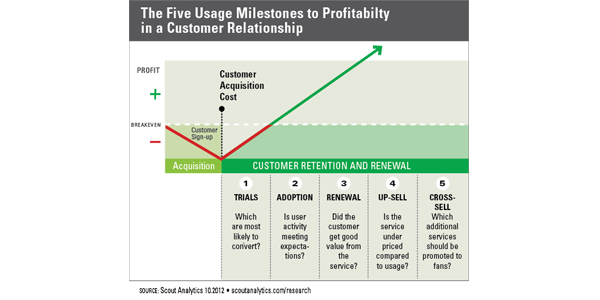Creating profitable customer relationships requires understanding and monetizing customer usage. This road to profitability is connected by five usage milestones that must occur during the lifecycle of each customer. These milestones are driven by individual usage factors such as customer adoption, return on investment, and growth. But how do companies in the subscription economy leverage these factors when pursuing strategies to minimize churn and maximize customer lifetime value?
Companies must have a clear understanding of the aforementioned usage milestones, and they must leverage usage data to create actionable segments for sales, marketing, and customer success teams who manage customer relationships.
The five usage milestones are: Trial, Adoption, Renewal, Up-sell and Cross-sell. Let’s look at each in more detail.

Trials
Trials serve as a common mechanism for generating leads, and they are a great tool for determining which leads are most likely to convert to a paying customer. By benchmarking usage patterns of trialists that become paying customers, you can identify lead scoring rules to create hot lead lists for sales. Our research shows that by focusing on trialists that reach a certain threshold or use the trial account on the last day, you can double conversion rates and lower cost of customer acquisition.
Adoption
After subscribing to the service, the adoption milestone depends on if customer usage is growing and meeting expectations. Reaching thresholds for active and total users within the first three months is critical to building momentum toward renewals and up-sell. Additionally, having 80 to 90 percent of the users active within six months is usually an indicator of growth and profitability. By monitoring usage relative to sign-up, customer success managers know how and with whom to intervene and grow usage.
Renewals
Renewals are the most critical milestones to profit – it is the customer milestone that extends revenue for another contract term. When it comes time to renew, customers evaluate whether they received good return on investment from a service by examining their own frequency of use. The better the ROI, the more likely they are to renew, but if the customer is basing the decision on a gut feeling rather than by way of actual usage data, you run the risk of having to discount or downgrade in order to prevent that customer from churning. Ensuring three months before renewal that the customer has maintained their usage levels and providing usage data as part of the renewal process is the best means to not only retain the customer, but to do so at the right price.
Up-sell
The up-sell milestone is pivotal to maximizing revenue. If the service is underpriced compared to a customer’s usage, this creates an up-sell opportunity either by moving to a new rate plan or increasing user counts. Most up-sell opportunities come from one of two sources: Either the customer is bumping up against limits in the current rate plan or they are using the service in a noncompliant manner (e.g., sharing user IDs). Usage data provides the optics into these two cases, often identifying 20 to 30 percent of accounts that could be upsold given the right data for negotiations.
Cross-sell
The final usage milestone is where the customer has received good value for their price paid, and is now considered for additional products. Knowing which features or facets of a service the customer uses most will enable sales and marketing to make targeted offers for cross-selling. For example, a heavy user of marketing campaign management may be a good cross-sell for the marketing dashboard. Through deep segmentation of usage, customers can be segmented into relevant cross-sell campaigns.
Regardless of the milestone, usage data plays a critical role in managing a customer relationship to profitability. Whether early in the trial to differentiate which prospects will close, or at the renewal stage to determine risks, up-sells, and cross-sells, usage data can be used throughout the customer lifecycle to increase revenue and profits. Using those optics, product management can design pricing to maximize yield, sales teams can target customers with the most potential, and customer success managers can engage the customers most at risk.






